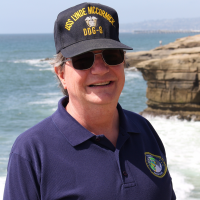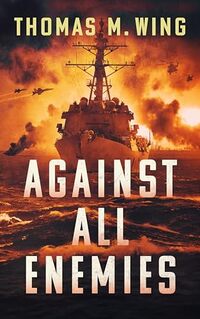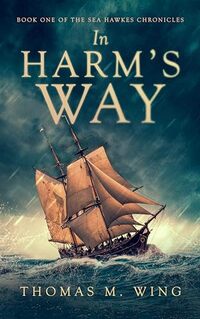Your novel “Against All Enemies” stemmed from a random thought during a period of political tension between China and the U.S. Can you share more about that moment of inspiration and how it shaped the story?
The random thought was the catalyst for connecting some things I’d been thinking about for some time. I’d always wanted to write a story with a main character who was a destroyer captain. I’ve also long been interested in military fiction, similar to Tom Clancy, Dean Koontz, Kevin Miller, etc. And, I took the advice of George Galdorisi, a friend who now writes the Tom Clancy Op-Center novels for the Clancy estate. He told me he writes “what if” stories that center on things he is concerned could happen, if events go a certain way. The convergence of all those things was touched off by that random, intrusive thought.
With your extensive Navy experience, including real-world joint operations and combat, how did your time in service influence the authenticity and detail in your novel?
I’ve put down books that had a half-way decent story, but were completely unrealistic with respect to their portrayal of the military, especially naval warfare. So I hold myself to a very high standard for authenticity. I want the orders passed in CIC, the helm orders on the bridge, the way message traffic is written, callsigns used for ships, all that, to be authentic. Then, I have to balance that desire with the requirement to not accidentally divulge classified information, or have the book in aggregate reveal classified information. The review by the SSO classification folks reassured me that the things I’d changed to avoid classification issues were adequate, without sacrificing authenticity. But, man, was achieving the balance difficult! Callsigns and weapon systems capabilities were the hardest. Every fiber of my being wanted to use the right format for callsigns, but I just couldn’t. And the conversation I had with my classification reviewer confirmed that if I’d used the format, they’d have made me change it, anyway. Weapon systems capabilities were slightly easier, as I used defense contractor numbers; they’ve already been reviewed by the Defense Department and approved for public distribution.
Operation Praying Mantis is a lesser-known yet significant event in naval history. How did your participation in that operation inform your understanding of modern naval warfare?
That was the largest naval battle since World War II, encompassing surface and air warfare across the breadth of the Arabian Gulf, lasting 24 hours. The combat the Navy has seen against the Houthis of late has been just as intense, and lasted months instead of days, but has been exclusively an air threat. All the training I’d had to that point had prepared me for the processes and events, even how to “check your emotions at the watertight door." But nothing prepares you for the intensity, and those emotions. So I brought those to my story. It was also my first real look, other than reading histories of World War II, at naval warfare across a large sea and land area, encompassing multiple groups of ships in different locations.
You’ve worn many hats—from commanding ships to teaching Coast Guard licensing courses. How have these diverse experiences shaped your perspective as a storyteller?
I’ve always been a storyteller, even when it was only telling myself a story, to get to sleep at night, or while daydreaming in grade school….don't do that, kids! But those experiences and roles let me meet an incredibly diverse set of folks, and those people helped me understand people better. At least, I think so. The folks I met in the military were diverse in some ways, coming from all over the nation. But there’s a culture in the Navy and the other services that we have in common. Merchant sailors are sailors, but they’re quite different from Navy sailors, have a different culture. The experience with the sail training community was even more unique than the merchant world. So I bring those different perspectives to my stories, as well.
What challenges did you face in translating your military expertise into a compelling narrative that resonates with both civilian readers and those with military backgrounds?
That’s a struggle, and I still have a difficult time with it. For some readers, the glossary and inserting explanations just haven’t been enough, and I sympathize with them. The basic answer is that I read, a lot, in several different genres. It’s allowed me to pick up some methods for inserting short explanations that don’t interfere with the narrative. I’ve also taken workshops from an author friend on toning down the technical just enough to keep those readers who want that stuff, without losing those for whom it’s so totally foreign that it might as well be a different language, which it is in some ways.
Your involvement with the Continental Navy Foundation focused on experiential education at sea for young people. How did that work shape your views on leadership and teamwork, and did those themes make their way into your novel?
My Navy experience showed me several different leadership styles, and I saw a few really poor leaders. I also saw a lot of fantastic leaders. But civilians, and especially young people, are different in many ways. There are leadership tools that will not work with young folks. So that required adapting my style. On the other hand, it also showed me that many leadership techniques cross all situations and are applicable to all people, regardless of age. As far as teamwork goes, everyone wants to be on a team, to be an important member of the team, and contribute. Even the kids who wanted to be “too cool” really wanted it, down deep. You just have to find the trigger that brings that desire to the light of day, and lets them play. And yes, everything I learned about teamwork and leadership finds its way into my stories. I recently told one of my former commanding officers that Bill Wilkins had many of the traits I respected about him when he was CO of my third ship. It was very rewarding to be able to say that!
Writing a thriller that features cruise missiles striking the San Diego waterfront must have hit close to home. How did you balance realism with sensitivity, given your connection to the region?
I actually was accused of hating my workplace after a couple of folks in my chain of command read the prologue! But I didn’t hate it at all. I just needed an inciting event that forced my destroyer to be alone in the South China Sea, unable to communicate with its chain of command. To achieve that, I had to make the attack significant enough to take down communications. And to be honest, the scale was tipped way over to realism. If I’d let sensitivity have too great a role, there were several events I wouldn’t have been able to write. And, I have to admit, I was putting a message in the story: we’ve let our defense industries consolidate to the point where we really are vulnerable. One massive missile factory location producing all American missiles? Come on, that doesn’t make sense. And the classification folks were okay with it.
Were there particular scenes in “In Harm's Way” that you found emotionally difficult or exhilarating to write because of your personal experiences?
When I first conceived In Harm’s Way, I had just returned from my fourth six-month deployment aboard a ship. So homecoming after a long time at sea was in the forefront of my mind. It also worked as a good place to start the story. So when I wrote the homecoming scenes, my own was fresh in my mind: all the anticipation, the joy, the release of months of stress and tension. I’ve seen a lot of sailors come home to a new child, which always brings tears to my eyes. But I’ve also seen my share of “less than good” homecomings. A sailor coming home to a spouse who’s left them, a deceased parent who’s not on the pier, or some other personal tragedy. I needed Jonas’s wife to be vulnerable when he came home. She’s a strong colonial woman, which I hope comes out as the story unfolds. But now he’s home, she collapses in her own grief, because she doesn’t have to hold it together anymore. She recovers quickly, but when he arrives home, the tragedy makes his losses complete. And that is where I needed him to be as his character arc starts: devastated by personal and professional losses. What does he do now?
Did you draw inspiration from any real-life naval colleagues or mentors when developing your characters?
I mentioned an old CO before, his being an inspiration for Captain Wilkins. Admiral Simpson in Against All Enemies is also modeled a bit on a commodore I worked for, with other characteristics taken from other flag officers I knew and served under. The admiral commanding Fifth Fleet in that book is very similar to the one who commanded Fifth Fleet when I served out there in 2008 and 9. That was the second time I’d served under him. Tough guy, and merciless. But a fantastic leader and good man. Jonas is an amalgamation of several officers I served with, and to a certain extent, my father. Any writer who says there isn’t any piece of a real human in his characters isn’t being honest with themselves, or their readers. It’s impossible to write a real human without reference to humans you’ve known.
As a Naval Academy and War College graduate, how did your formal education influence your approach to strategy and conflict in your fiction?
It gave me a greater perspective on the operational and strategic levels of war. As a young lieutenant serving in a ship, my perspective was narrow: the ship, and maybe, just maybe, at a very low level, the battlegroup. But the War College taught me to look at the whole of the military; the five elements of national power, and how they must be used in combination to achieve national goals; and how to put myself in the enemy’s shoes in order to try to understand his objectives. It’s rarely the obvious! The Naval Academy tried to get us to think in those higher realms, but only at an introductory level. What the Academy did accomplish was steeping me in Navy lore and tradition, and give me an even greater respect for those who went before. That’s the real inspiration for the series that In Harm’s Way begins.
Many military thrillers focus on the action, but your background suggests a deep understanding of operational planning and decision-making. How do you integrate these elements to build tension in the novel?
That was also difficult. My editor, the fabulous Laura Taylor, worked with me to both take out the boring elements associated with planning and decision-making, and spice up what was left to make it compelling. Essentially, it boiled down to minimizing the discussions, i.e. show, don’t tell; and making the decision-making critical, life and death stakes. Real world plans and decision matrices consider the highest stakes, as well as lower stakes, elements. Good story telling dies when low stakes planning and decision-making takes up space. But, that doesn’t mean I didn’t use those skills to develop the operational plans, or at least outlines, for the Chinese and Russian attacks in Against All Enemies! I just didn’t put the details in the story.
What do you hope readers take away from “Against All Enemies”—both about military service and about the broader geopolitical challenges we face today?
About military service? That military folks are human, with all the foibles that civilians have. They’re trained to model certain responses, and not to let emotions keep them from doing their jobs. But the emotions are there, and sometimes boil over. Bill’s eyes water when a young officer he’s grown fond of as a mentor, dies. That’s real. As for the challenges we face today, the takeaway is that there are consequences for everything that our national leadership says and does. Not all of them are foreseeable, but many are, and ignoring the potential consequences, as well as possible secondary and tertiary effects, is a recipe for disaster. A corollary is that the adversaries and allies get a vote. We cannot dictate what other nations will, can, or should do. They all have their own agendas. Sometimes those agendas mesh with our own. Often they don’t. Bill talks about that with his XO and Navigator. As an example, in the sixties, there were several collisions and near mishaps between US and Soviet ships. The US Chief of Naval Operations and the Soviet Navy head negotiated a set of signals for use between the two nations’ ships to reduce or eliminate the risk, since any incident had the potential to start a shooting war. The two heads of the most powerful navies in the world, adversarial in every other way, worked together to reduce the risk of unintentional war breaking out. Their need to avoid accidental catastrophic war overcame their adversarial positions. Good story. We need leaders like those today.
You’ve lived a life so closely connected to the sea. What draws you back to the water even now, and does that passion influence your writing process?
I grew up near one of the largest fresh water lakes in the country, outside of the Great Lakes. I can’t tell you exactly what it is about large bodies of water that draws me in, but I can tell you I can’t be far away from one. The sea is unchanging, yet ever changing. I’m not the first to express that, I know. It’s power, its majesty, they put me in awe every time I see it. I’ve seen the sea dead calm, flat, not a ripple except that made by my ship’s passage. Then a flying fish leaps from near the bow and flaps away, fifty, a hundred, two hundred yards, leaving a furrow on the surface. A few hours later, the wind is up, the spray is flying, and the ship is rolling. Whitecaps abound. Both are beautiful. And storms! Don’t get me started. I was the guy who would spend whatever minutes off watch I could, standing on the bridge, watching the bow plunge into the waves, green or blue water rushing feet deep back along the deck, breaking against the forward gun mount or missile launcher, with spray blasting against the windows and flying back over the bridge. My Lord, what power! We are puny before it. I guess it’s like an adrenaline junky. I can’t ever get enough of being in awe.
What’s next for you as an author?
Finish the trilogy that starts with In Harm’s Way. Then, move on to a World War II novel, which might need to be a duology - two books. It’s very loosely based on my father’s and two uncles’ service in that conflict. My father was Army, one uncle was Navy and fought through the most challenging naval warfare around Guadalcanal, and another uncle was Army Air Corps. He was captured on Bataan, survived the Death March, and three and a half years in Japanese prison camps. I’ve fictionalized their stories, but I wanted to capture what men, and women went through in those days, especially in theaters of war that aren’t well covered in fiction, such as North Africa, and the POW’s. After that, I’ll return to the Sea Hawkes Chronicles. William will be in the new American Navy, and fight in both the Quasi-War with France, as well as the Barbary Pirate conflicts. Then, he and his son will participate in the War of 1812. The series will continue as long as I can keep writing it.
How has your experience with AllAuthor been?
I have had a great time with AllAuthor! I love the book mockups, and I use them in my social media posts. I even use one as my Zoom background. The tweets have been fantastic, and I really believe they keep awareness of my books higher. Sadly, I do not spend as much time on social media as I should, and I feel like AllAuthor takes up part of the slack. For that, I’m grateful! Sales continue to be good, even though AAE has been out for over a year and a half. That’s great for a small press book!














